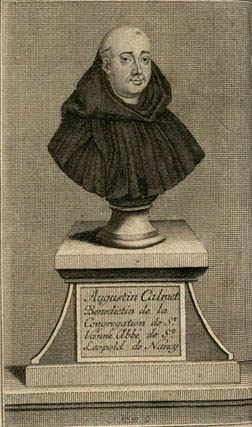Antoine Augustin Calmet
Augustin Calmet ( born February 26, 1672 Menil -la- Horgne at COMMERCY in the Duchy of Lorraine, † October 25, 1757 in Senones ) was a Roman Catholic theologian, scholar and abbot of the Benedictine order.
Life
Calmet was born in Menil -la- Horgne at COMMERCY the son of a blacksmith, and christened with the name Antoine. The young Antoine Calmet retired already in his early youth in the nearby Benedictine monastery of Breuil at COMMERCY back. There, and also at the University of Pont-à- Mousson, one lying on the Moselle between Nancy and Metz town, he studied. Through his outstanding abilities, his diligence and his winning disposition, he soon attracted the benevolence of his monastic teachers.
In 1688, at the age of 16, he became a full member of the Benedictine Order, took the name Augustine, for the holy church father Augustine, and was some time later, in 1696, ordained priest. In addition, he distinguished himself among his friars particularly through his tireless scientific studies, so that he in the Abbey of Moyenmoutier held a teaching position in philosophy and theology already in 1698. This still followed in 1704 the subject of biblical exegesis in the abbey of Munster in Alsace, in which he also performed the duties of Subpriors.
His tireless effort and irreproachable character reached that he in 1715 prior of the monastery of Lay, a short time later, in 1718 abbot of St. Leopold at Nancy in 1728 and abbot of the monastery of Senones been in years. Twice elected him to his congregation, which belonged to no less than 50 monasteries, its president. Pope Benedict XIII. wanted him therefore been appointed titular bishop, but Calmet rejected this suggestion modestly. So he stood his monastery Senones until his death in front of the abbot.
Wilhelm Fink characterized Calmet in the first edition of the lexicon for Theology and the Church: "Just as pious and humble as taught and worked tirelessly; as a writer extremely fruitful. Godefroy has 35 self-employed, mostly multi-volume works, of which only 6 published after his death. " Leonhard Hell calls him in the third edition of the most important Catholic exegetes of the 18th century next to Richard Simon. In addition, he held numerous scholars, such as Voltaire, contact.
Works
Calmets scientific and literary heritage is of great importance. His principal work is his undisputed, in the years 1707 - 1716 in 23 corpulent large-format volumes published in the French language Bible commentary under the title La Sainte Bible en latin et en françois, avec un commentaire littéral et critique, which very favorable reception was also at the Protestant population; he is the best and largest ever released in France commentary on the Holy Scriptures, and lived during the 18th century several editions. This work has never been translated into the German language, but it appeared in 1720 an extract consisting of 135 essays under the title Dissertations qui peuvent servir de l' ecriture sainte de Prolegomenes, which in 1738, 1744 and 1747, three German editions under the Title Biblical studies or treatises of different pieces to the understanding of healing. Scripture serve experienced.
He also authored a Biblical Lexicon under the title Dictionnaire historique et critique, chronologique, Geographical location littéral et de la Bible. It appeared in three volumes in the years 1722 - 1728, this work also through several editions, and was in the Latin, English, Dutch, and the years 1751 - 1754 in four volumes under the title Biblical Dictionary, worinnen what the history, Critique, chronology, geography, and heard the literal sense of Scripture is translated into the German language discussed.
Furthermore, in 1718, a Bible story appeared. It covers the period from the Creation to the destruction of the Jewish Temple in Jerusalem by the Romans in 70 AD and bears the title Histoire de l' ancien et sainte du Nouveau Testament et des Juifs; these through several editions. An English translation appeared in 1740, a German edition under the title of Biblical history, or story - Description of the Old and New Testaments. Wherein especially the history of the Jews, from the beginning of the world until the Zerstöhrung the city of Jerusalem, and their utter distraction carried out, is dealt with in 1759.
Other notable works are the Histoire universelle sacrée et profane, depuis le commencement du monde jusqu'à nos jours, 1735 in French, and in German language under the title General churches and world history from the Creation to down to our own times from 1776 - 1797 was published in 12 volumes, further 1728 Bibliothéque Lorraine, Lorraine's writers and their works listed, a Commentaire littéral historique et moral sur la regle de saint Benoît, a commentary on the monastic rules of the Benedictines, which was published in 1734, and a history of the Duchy of Lorraine in the years 1745-1757 under the title Histoire ecclésiastique et civile de Lorraine ... in seven volumes, commissioned by Duke Leopold ( 1679-1729 ), but which was left unfinished by his death. It represents a significant achievement represents, which is based on comprehensive source works and is still of great historical value.
Today we know Augustine Calmet mainly for its 1746, first published in French book Dissertation sur les apparitions des anges, the démons et des wit. Et sur les Revenans et vampires. De Hongrie, de Boheme, de Moravie et de Silesie in which Calmet extensively addresses the in his time, and more recently held events on ghosts, witchcraft, possession and vampirism. The writing was at that time translated into all major European languages , a German edition appeared in 1749 for the first time under the title of scholar negotiation of the material phenomena of Geisteren, and those vampires in Hungary, Moravia etc. .. Calmet looked for this publication exposed to the criticism from the Enlightenment philosophers and materialists, as he explained the phenomena on purely theological basis.

.jpg)


